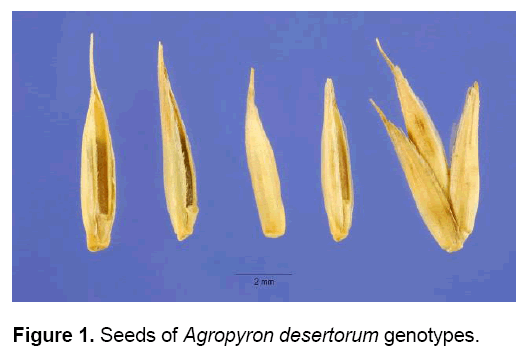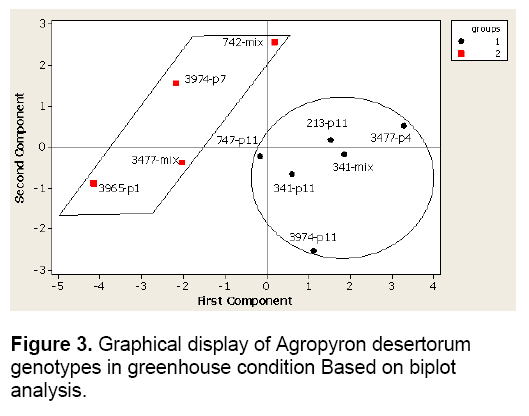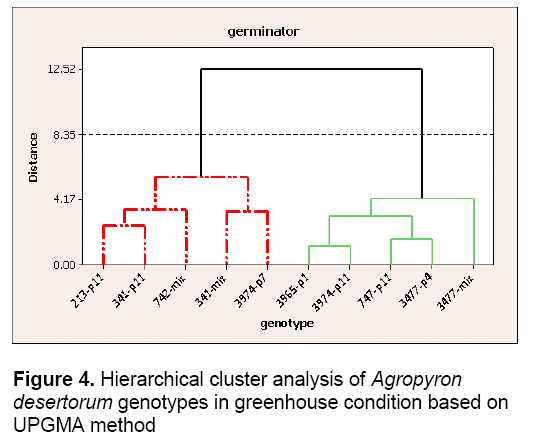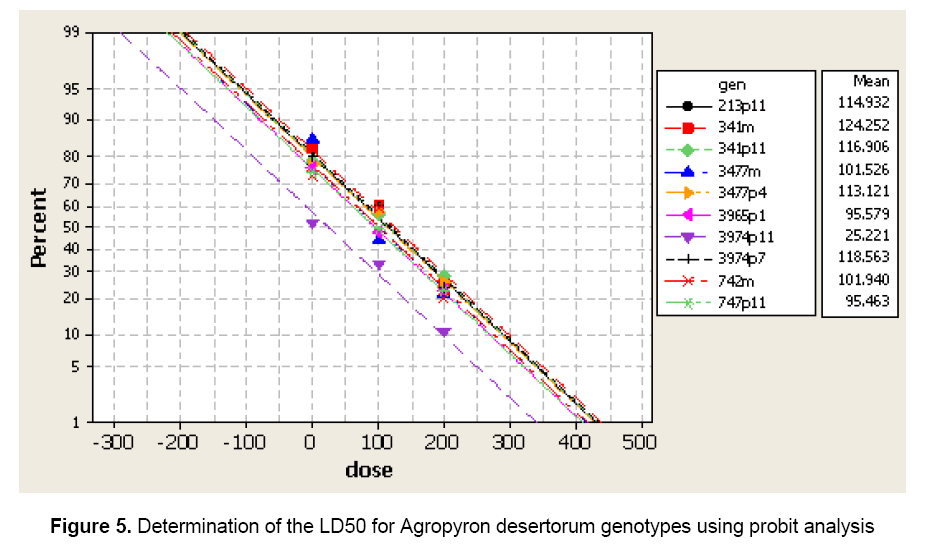Probit Analysis and Heritability of Salinity Tolerance in Agropyron desertorumGenotypes
Ahmad Reza Golparvar
Department of Agronomy and Plant Breeding,Khorasgan (Isfahan) Branch,Islamic Azad University,Isfahan,Iran
- Corresponding Author:
- Ahmad Reza Golparvar
Department of Agronomy and Plant Breeding
Khorasgan (Isfahan) Branch
Islamic Azad University,Isfahan,Iran
E-mail: dragolparvar@gmail.com
Abstract
Germination ability and salt stress tolerance of Agropyron desertorum were evaluated using ten genotypes originally collected from different areas of Iran in greenhouse condition. Five different concentrations of NaCl solution were used in this experiment. Analysis of variance showed considerable variation in all the germination attributes under salinity stress. Principal component analysis revealed that first and second components accounted for about 97.6 percent of the total variation among the traits studied. The first component included root length, plumule length, seedling length and seed vigor and accounted for 62.3 percent of the total variation among the traits. This component entitled as the seed germination ability. Hierarchical cluster analysis classified the genotypes in three groups. In conclusion, selection for the higher amounts of the traits root length, plumule length, seedling length and seed vigor can improve the seed germination ability and salinity tolerance in Agropyron desertorum genotypes at the seedling stage in greenhouse condition. Furthermore, crosses between the genotypes classified in the clusters 1 and 3 causes to broadening genetic variation and possibility of the efficient selection among the progenies obtained from these crosses
Keywords
Agropyron desertorum,heritability,cluster analysis,probit analysis,PCA.
1. Introduction
A-biotic stress such as salinity whether from soil or water affects plant growth and development due to salt-induced water deficit,low uptake and accumulation of essential nutrients,and high accumulation of toxic ions such as Na+ and Cl-. All these factors cause changes in a wide variety of physiological and biochemical processes such as photosynthesis,protein synthesis and nucleic acid metabolism [1,2]. Reclamative and preventive measures for rendering salt affected soils fit for crop production are usually expensive and generally considered temporary solutions.
Alternatively,selection and breeding of cultivars tolerant to salinity is a feasible and economical approach for utilizing salt affected soils [3]. However,the success of this approach depends on the presence of genetic variation in the gene pool of a species. For example,variability for salt tolerance,within and between species,has been found in cultivated and wild species such as wheat (Triticum aestivum L.) [4],sorghum (Sorghum bicolor (L.) Moench.) [5],Agrostis stolonifera and Festuca rubra [6]. Similarly,while evaluating 25 and 60 strains of Agropyron desertorum for salt tolerance,Dewey DR [7,8] found a few strains tolerant to salt stress. Likewise,Ulfat M et al [9] screened 32 lines of canola and they were able to identify 5 highly tolerant lines. Since seed germination and seedling growth under saline conditions are critical for establishment of plant population [10,11],screening of different accessions or cultivars of a species at the germination stage in greenhouse condition may lead to find out salt tolerant genotypes at seedling stage. Agropyron desertorum is one of the important species of the Poacea family. This plant naturally grows in most rangelands where high salt content is the characteristic of most soils. In view of this information,it was hypothesized that different accessions of Agropyron desertorum growing in different areas with different climatic conditions might have evolved some obligatory adaptational characters,including that of salt tolerance. Therefore,the present study was achieved to evaluate genetic variation for germination attributes under salinity stress condition by screening ten different accessions of Agropyron desertorum at the germination stage. The intra-specific variation so explored for salt tolerance could be exploited in future breeding programs for the improvement of salt tolerance trait,the best crosses between Agropyron genotypes and selection of the genotypes tolerant to salinity stress.
2. Materials and Methods
2.1 Plant material
Ten Agropyron desertorum accessions (213-p11,341-mix,341-p11,3477-p4,3974-p11,3965-p1,3477-mix,3974-p7 and 742-mix) used in the present study were obtained from the Kradj Agricultural Research Center,Karadj,Iran. Before sowing,seeds were surface sterilized in 5% Sodium hypochlorite solution for 5 minutes. Five different concentrations of NaCl (0,100,200,300 and 400 mM) in Hoagland’s nutrient solution were used. The experiment was setup in a completely randomized (CRD) factorial design with four replicates in greenhouse of the Department of Plant Breeding,Islamic Azad University,Khorasgan Branch,Isfahan,Iran. The research station is located in east of Isfahan (32° 38'N 51°47'E) with 1550 m elevation. Region climate was dry or cold dry according to Demartin and ambergay methods,respectively. Mean annual precipitation is 114.5 mm and mean temperature of region is 15.1°c. Maximum temperature in July was 42.6°c and minimum in January was 17.25°c. Evapotranspiration of this region is 1723.25 mm per year. Soil texture was silty-loam with 1.5% of organic carbon,0.02% of nitrogen,20 p.p.m of available phosphorus,504 p.p.m of available potassium,pH=7.37,acidity of 7.8 and 3.5 mmohs/cm electrical conductivity in 0 to 30 cm depth. Fifty seeds of each accession were allowed to germinate in a pot at greenhouse with efficient amounts of NaCl solution. Salt levels were maintained daily by dripping out and applying fresh salt solution twice (Figure 1).
2.2 Data collection
Germination was recorded daily and a seed was considered germinated when the radicle attained length ≥5 mm. After 7 days of sowing,germinated seeds were collected,their plumules and roots carefully separated and fresh and dry weights recorded. Germination percentage,germination rate,plumule length and root length also recorded for each experimental unit (Figure 2 ).
2.3 Statistical analysis
The data obtained from the experimentation were subjected to a two-way analysis of variance,principal component analysis,cluster and probit analysis to determine the best selection criteria,crosses and the most tolerant Agropyron desertorum genotypes by using the SAS9 and SPSS18 statistical softwares.
3. Results and Discussion
3.1 Simple anova
Analysis of variance showed the significant differences for seed vigor index,germination percentage,plumule length,root length,germination rate and seedling dry weight between genotypes,salinity stress levels and their interactions (Table 1).

3.2 PCA
Principal component analysis revealed that the first and second principal components accounted for 62.3 and 35.3 percent of the variation exist amount the traits,respectively. The first component comprises root length,plumule length,seedling length and seed vigor. Therefore,this component was entitled as seed germination ability mean while selection for the higher amounts of these traits can improve the seed germination ability in Agropyron desertorum genotypes. The second component involved fresh and dry weight of seedling. Biplot graphical display (Figure 3 ) classified the genotypes in three main groups that designated considerable genetic diversity for salinity tolerance and germination traits in Agropyron desertorum.
3.3 Cluster analysis
Cluster analysis based on UPGMA method also classified the genotypes in three distinct clusters similar to biplot analysis (Figure 4 ). Cluster1 comprises 213-p11,341-mix,341-p11 and 3477-p4. On the other hand,cluster 2 involves 3974-p7 and 742-mix genotypes. Clusters 1 and 3 have the highest genetic distance. Therefore,crosses between the genotypes belong to these clusters have promising genetic efficacy to improve germination ability and tolerance to salinity stress in Agropyron desertorum genotypes. Genotypes 341-mix and 3974-p11 showed the highest and lowest germination percentage and germination rate,respectively. Significant interaction effect between genotypes and salinity stress levels for germination percentage indicated different reaction of genotypes to salt stress. These dictate on the necessary of selection among these genotypes for different salinity levels. Arab F [12] reported reduction in seed vigor index with increase in salinity stress intensity among Agropyron and Atriplex accessions. This result is in consistent with my findings.
3.4 Probit analysis
Probit analysis (Figure 5 ) showed that 341-mix was the most salinity stress tolerant and 3974-p11 the most sensitive Agropyron genotypes. The genotype 341-mix showed LD50 higher than other genotypes. The highest amount of seedling length was observed in 341-mix and 3974-p7 genotypes. Arab F [12] and Jafari M [13] also reported significant difference between Agropyron genotypes for this trait. Other researchers found sever reduction in plumule length more than root length that is same with my findings in Agropyron desertorum and Panicum turgidum Forssk [14,15].
3.5 Heritability estimation
Estimation of broad-sence heritability for the studied traits in Agropyron desertorum indicated that seed vigor rate and germination rate having 63 and 68 percent showed the highest heritability. Therefore,selection for these traits has proper efficiency in breeding of these traits. Sabir P and Ashraf M [11] and Munns R et al. [3] reported the similar results.
4. Conclusion
In conclusion,selection for the higher amounts of the traits root length,plumule length,seedling length and seed vigor will increase the seed germination ability in Agropyron desertorum genotypes. Crosses between the genotypes classified in the clusters 1 and 4 causes to broadening genetic variation,transgressive segregation and possibility of the efficient selection among progenies exhausted from these crosses.
Acknowledgements
This research project has been supported by Islamic Azad University,Khorasgan (Isfahan) branch,Isfahan,Iran. This support is highly appreciated.
References
- Ashraf M. (2004). Some important physiological selection criteria for salt tolerance in plants. Flora,199: 361-376.
- Munns R. 2005. Genes and salt tolerance: bringing them together. New Phytol,167(3): 645-663.
- Munns R.,James R.A.,Lauchli A. (2006). Approaches to increasing the salt tolerance of wheat and other cereals. J. Exp. Bot,5(57): 1025-1043.
- Kingsbury R.W.,Epstein E. (1984). Selection for salt-resistant spring wheat. Crop Sci,24: 310-314.
- Azhar F.M.,McNeilly T. (1988). The genetic basis of variation for salt tolerance in Sorghum bicolor (L.) Moench.,seedlings. Plant Breed,101: 114-121.
- Ashraf M.,McNeilly T.,Bradshaw A.D. (1986). The response of selected salt-tolerant and normal lines of four grass species to NaCl in sand culture. New Phytol,104: 453-461.
- Dewey D.R. (1960). Salt tolerance of twenty five strains of Agropyron. Agron J,52: 631-635.
- Dewey D.R. (1962). Breeding crested wheat grass for salt tolerance,Crop Sci. 2: 403-407.
- Ulfat M.,Athar H.R.,Ashraf M.,Akram N.A.,Jamil A. (2007). Appraisal of physiological and biochemical selection criteria for evaluation of salt tolerance in canola (Brassica napus L.). Pak. J. Bot,39(5): 1593-1608.
- Noreen Z.,Ashraf M.,Hassan M.U. (2007). Inter-accessional variation for salt tolerance in pea (Pisum sativum L.) at germination and seedling stage. Pak. J. Bot,39(6): 275-285.
- Sabir P.,Ashraf M. (2007). Screening of local accessions of Panicum miliaceum L.,for salt tolerance at the seedling stage using biomass production and ion accumulation as selection criteria. Pak. J. Bot,39(5): 1655-1661.
- Arab F. (2006). The effect of different salinity stress on germination traits and seedling growth of two rangeland species. M.Sc thesis. Tehran University,pp. 190.
- Jafari M. (1994). Assessment of salinity resistance in some of Iranian rangeland plant species. First edition. Publication of forest and rangelands research institute of Iran,pp. 350
- Lauchi A.,Epstein E. (1990). Plant responses to saline and sodic conditions. Pp. 113-137. In; K.K. Tanji. Agricultural Salinity Assessment and Management. ASCE. Publication,pp. 619.
- Al-khateeb S.A. (2006) Effect of salinity and temperature on germination,growth and ion relations of Panicum turgidum Forssk. Bioresource techn,97: 292-298.

Open Access Journals
- Aquaculture & Veterinary Science
- Chemistry & Chemical Sciences
- Clinical Sciences
- Engineering
- General Science
- Genetics & Molecular Biology
- Health Care & Nursing
- Immunology & Microbiology
- Materials Science
- Mathematics & Physics
- Medical Sciences
- Neurology & Psychiatry
- Oncology & Cancer Science
- Pharmaceutical Sciences





